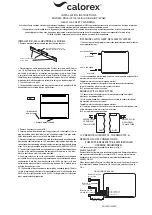
M
–
Basic
Maintenance
M
‐
2
Pool
Water
Chemistry
.
Incorrect
pool
water
chemistry
(improper
pH
level
or
high
concentration
of
chlorine,
sea
salt
or
other
corrosive
additives
etc.)
can
result
in
equipment
premature
wear
or
malfunction
(let
alone
poor
air
quality
in
the
pool
and
potential
health
issues)
and
will
void
the
equipment
warranty.
Refer
to
pool
water
quality
standards;
contact
factory
as
needed.
Routine
Maintenance
Program
Creating
facility
‐
specific
routine
maintenance
program
and
following
it
is
vital
to
equipment
longevity
and
efficient
operation.
The
suggested
general
maintenance
operations
and
their
frequency/intervals,
listed
in
the
table
M
‐
1
below,
can
be
used
to
create
such
a
program.
For
more
detailed
maintenance
recommendations
related
to
specific
components,
refer
to
the
respective
component
manufacturer’s
manual.
Table
M.1.
Recommended
Maintenance
Tasks
and
Intervals
Interval
Maintenance
Task
Weekly
Observe
the
equipment
for
any
changes
in
running
conditions
and
unusual
noise
Quarterly
Clean
or
replace
air
filters
if
clogged
or
dirty
Verify
that
all
set
‐
points
are
correctly
programmed
as
specified
by
the
facility
operator
Semi
‐
Annually
Inspect
and
clean
the
drain
pan(s)
Tighten
electrical
connections,
if
required
Check
and
tighten,
if
required,
pool
water
hose
clamps
and
sensor
mounts
Inspect
all
airside
coils
(outdoor
condenser,
fluid
cooler,
dehumidifier
coils
–
evaporator,
etc.)
for
dirt,
cobweb
build
‐
up,
etc.;
clean
as
needed
Check
that
the
P
‐
trap
is
primed
(filled
with
water).
It
is
good
practice
to
pour
some
water
into
the
drain
pan
to
ensure
that
the
P
‐
trap
is
primed
and
operational
Check
the
outdoor
air
louvres
and
dampers
for
accumulation
of
dust
and
clean
as
required
Inspect
the
equipment’s
cabinet
for
corrosion.
If
any
damage
is
found,
clean
and
repaint
the
affected
surface
with
a
rust
‐
resistant
primer
Annually
Clean
the
fan
wheel(s)
Check
dampers
operation
(linkage/actuator
is
not
loose,
damper
opens/closes
properly
etc.)
Inspect
electrical
components,
wiring
and
insulation
Rotate
the
fan
wheel(s)
and
check
for
obstructions
and
rubbing
Check
gasket
condition
on
all
doors
to
ensure
an
airtight
seal
Check
bolts
on
compressors,
motor
mounts,
dehumidifier
bases
and
coils
and
tighten
if
required
Verify
that
the
airflow
around
the
remote
condenser
or
dry
cooler
is
unobstructed
Содержание CLASSIC NE-002
Страница 3: ...B Table of Content B 2 This page is left blank...
Страница 10: ...C General Information OMM C S SL 01 C 7 February 2020 Pic C 4 B...
Страница 17: ...D Layout and Components D 6 This page is left blank...
Страница 21: ...E Sequence of Operation E 4 This page is left blank...
Страница 25: ...F Interface and Communication F 4 This page is left blank...







































